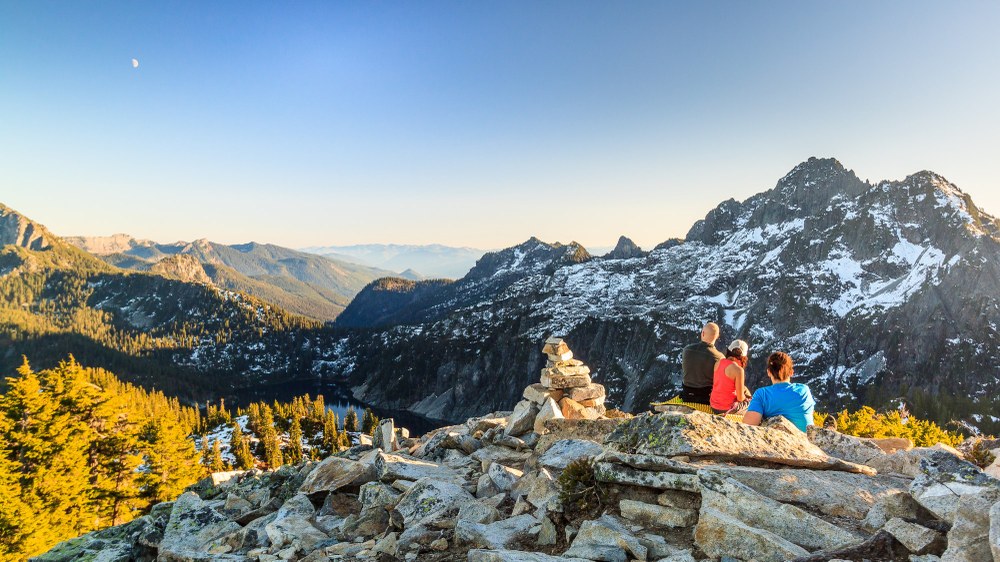
Outdoor activities have the tendency to escalate into bigger and more complex pursuits, and hiking is no exception. Even if you start with only an interest in moderate day hikes, you may soon be eyeing longer and more difficult trails. With long hikes, you assume more risk than on a day hike near town, and you may find yourself in remote places without cell service and few people on-trail to help if something goes wrong. Follow these tips to navigate this middle ground between hiking and backpacking responsibly:
Bring Extra Layers
Weather can be unpredictable, and if you’re on a 10+ mile hike it’s going to be that many more miles of miserable before you’re able to get back to the car and warm up or dry off. If you somehow become injured and have to spend a night on the trail, that extra set of clothing could be critical when the light begins to fade. Be sure to bring spare socks, wind and rain protection, an extra mid-layer, and bug protection.
Bring Extra Food
The same logic for layering applies to food. Though you should also be bringing extra food on casual day hikes, on more remote trips you will want to bring around 1.5x the amount of food you think you will consume that day. This is both because it’s good to have emergency rations, and it’s nice to have something to nibble on during the long drive back home. Bring something that is, of course, compact and high in calories and protein. An extra meal and supplemental snacks like trail mix are a good choice.
Curious about how many calories you should carry while hiking? Check out this burn-rate calculator.
Log the GPS Coordinates of the Trailhead
Always use the coordinates of a trailhead – addresses are frequently bungled on map apps, but GPS coordinates are not. Getting lost is not only annoying, it also burns daylight and gas, which can be risky depending on how far out you are. GPS coordinates remove the potential for confusion, which is helpful both for getting yourself there and for letting other people know where you will be.
Plan Your Drive
Print out or screenshot the directions on your phone in case you lose service. If you do lose service, be sure to note the miles on your odometer every time you reach a turning point in the directions, and base your movements off that. It’s common sense, but many of us navigate the world with instantly accessible maps, and it’s easy to forget just how reliant we are until those tools are no longer accessible. Keep the need for basic, old-fashioned navigation in mind – driving around until you ‘find it’ is not a wise choice. Tracking mileage, with some flexibility knowing that directions may not be accurate down to the quarter mile, is especially helpful if you’re driving at night and unable to rely on landmarks.
Those driving high-clearance vehicles with larger-than-stock tires should keep in mind that their odometer is not totally accurate, and calculate that difference in for long distances. If you plan to drive into no-service areas frequently or for long stretches, downloading a backcountry navigation app and maps for the area is a wise choice.
Tell Someone Where You’re Going
Tell someone where you’re going and how long you plan to be out, with a time that you expect to be back in cell range. Choosing one person you send this to every time keeps things simple. Send them the GPS coordinates and the information you’re using to get yourself there and navigate the trail. There are often alternate routes both to the trailhead and on the trail, and it’s important for them to know what information you’ve based your navigation on in case you do get lost or injured.
Always Have More Gas Than You Need
You don’t want to find yourself deep into a service road with a quarter tank – it may result in a longer hike than you bargained for. If you’re concerned about being able to fuel up, bring a 5-gallon gas can and keep it in the trunk just in case.
Keep Your Phone Charged
Your phone battery is likely to get zapped on fall and winter hikes, especially on those that go above the tree line. The best way to avoid this issue is to keep your phone in a pocket close to your body, in a mid-layer if possible. Pants and some hiking leggings offer pockets to store it in, but keep the screen facing outward as it will get sweaty.
Always bring a backup battery and charging cord as well in case you need your phone for offline navigation or an emergency call. Don’t forget that your backup battery is equally susceptible to drain from the cold.
Have On-Trail Navigation Skills
Do you know which way north is? Do you know how to find your coordinates on your phone with no service? Do you know what a cairn is? Do you know which direction you’ve been hiking in for the last 45 minutes? You should. Navigation skills are crucial, especially if you place yourself in a remote area where trail maintenance is irregular and route-finding skills are needed. Have at least a basic understanding of navigation and route-finding before you go out. To develop this skill set, check out one of our navigation courses. There’s a good reason we require it for many of our courses.
Bring Your Ten Essentials
You’ve heard it before, but it bears repeating – bring your Ten Essentials. It may seem bulky or unnecessary, but all of the items on that list will seem like cheap insurance if you actually need to use them. Consider the extra weight in your pack a conditioning aid.
 Hailey Oppelt
Hailey Oppelt